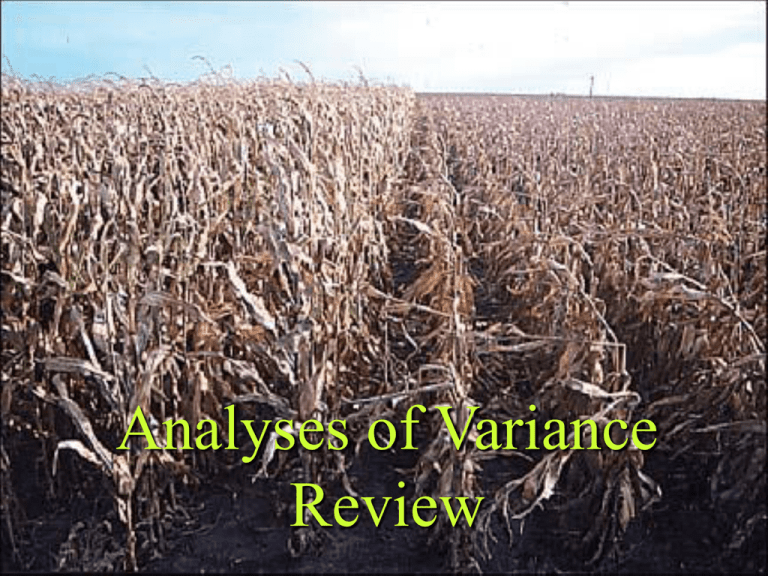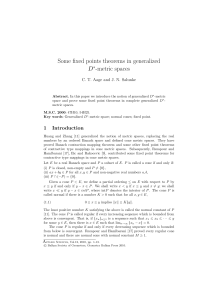AOV-Summary
advertisement

Analyses of Variance
Review
Simple Situation
Genotype A
135
Genotype B
34
Simple Situation
Genotype A
135
115
102
110
115.5
Genotype B
34
76
83
64
64.2
t-test
|x1-x2|
t=
2[(12+22)/(n1+n2)]
More than two treatments
Rep.
Genotype
Brundage Lambert Croft
Stephens
1
64
78
75
55
2
3
4
5
6
72
68
77
56
95
91
97
82
85
77
93
78
71
63
76
66
49
64
70
68
Multiple t-tests
Brundage
v Lambert; Brundage v Croft;
Brundage v Stephens; Lambert v Croft;
Lambert v Stephens; Croft v Stephens.
Problems?
If all tests were done at 95% significance
level, and one difference was significant, we
have done 6 tests and would expect 1/20 to
be significant, at random.
Analysis of Variance
Is
an elegant and quicker way to
calculate a pooled error term.
Analysis is simple in simple designs but
can be complicated and lengthy in some
designs (i.e. rectangular lattices).
In some experimental designs the
ANOVA is the only method to estimate
a pooled error term.
Analysis of Variance
It
can provide an F-test to tests specific
hypotheses. (i.e. to test general
differences between different
treatments).
Can be an invaluable initial
contribution to interpretation of
experiments.
Theory of Analysis of Variance
ij(xij-x..)2 = ij[(xij-xi.) + (xi.-x..)]2
ij[(xij-xi.)2+2(xij-xi.)(xi.-x..)+(xi.-x..)2]
ij(xij-x..)2 = ij(xij-xi.)2+ki(xi.-x..)2]
ki(xi.-x..)2 = Between Treatment SS
ij(xij-xi.)2 = Within Treatment SS
Theory of Analysis of Variance
BTMS ~ 2n-1 df : WTMS ~ 2nk-n df
2n-1 df 2nk-n df ~ F Dist n-1,nk-n df
Theory of Analysis of Variance
Source of variation
df
EMS
Between treatments
n-1 e2 + kt2
Within treatments
Total
nk-n e2
nk-1
[e2 + kt2]/e2 = 1, if kt2 = 0
Assumptions behind the ANOVA
Assumption
of data being normally
distributed.
Homogeneity of error variance.
Additivity of variance effects.
Data collected from a properly
randomized experiment.
Analyses of CRB Designs
Yij = + ti + eij
Analysis of Variance of CRB
Source
df
Between
treatments
Within
treatments
k-1 [G12/n1 + G22/n2 … Gk2/nk] - CF
Total
SS
jk-k By difference
jk-1 [x112 + x122 + … + xjk2] - CF
CF = [xij]2/jk
Analyses of RCB Designs
Yij = + bi + tj + eij
Analysis of Variance of RCB
Source
df
Blocks
r-1
[B12 + B22 + … + Br2]/t – CF
Treatments
t-1
[T12 + T22 + … + Tt2]/r – CF
Error
Total
SS
(r-1)(t-1) By difference
rt-1
[x112 + x122 + … + xrt2] – CF
CF = [xij]2/rt
Analyses of Latin Designs
Yijk = + ri + cj + tk(ij) + eijk
Analysis of Variance of Latin
Source
df
SS
Rows
t-1
[R12 + R22 + … + Rt2]/t – CF
Columns
t-1
[C12 + C22 + … + Ct2]/t – CF
Treatments
t-1
[T12 + T22 + … + Tt2]/t – CF
Error
Total
(t-1)(t-2) By difference
t2-1
[x112 + x122 + … + xtt2] – CF
CF = [xij]2/t2
Efficiency of Latin Squares
cw CRB Design
[MSr + MSc + (t-1)EMS]/(t+1)EMS
If value response is 325, then latin square in
will increase precision by 225% over CRB
and CRD would have need 2.25 x 4 = 9
replicates to be as accurate.
Efficiency of Latin Squares
cw RCB Design
Row (RCB)
= [MSr + (t-1)EMS]/(t+1)EMS
Col(RCB)
= [MSc + (t-1)EMS]/(t+1)EMS
-19%
+266%
☺
+226%
-19%
☺
Analyses of Lattice Squares
Yijk = + ri +
a
bj
+
a
t k + eijk
Lattice Square ANOVA
Source
Reps
Blk(adj)
Intra error
T(adj)
Eff. Error
df
4
15
45
15
45
SS
5,946
11,382
14,533
24,030
16,605
MS
1,486
759
323
1,602
369
F
4.03 *
2.35 ns
4.34 **
-
Efficiency of Lattice Design
100 x [Blk(adj)SS+Intra error SS]/k(k2-1)EMS
100 [11,382 + 14,533]/4(16)369
117%
I
II
III
IV
I
II
III
IV
V
V
Dealing with Wrongful Data
It
is usually assumed that the data
collected is correct!.
Why would data not be correct?
Mis-recording, mis-classification,
transcription errors, errors in data
entry.
Outliers.
Dealing with Wrongful Data
What
things can help?
Keep detailed records, on each
experimental unit.
Decide beforehand what values
would arouse suspision.
Dealing with Wrongful Data
What
do you do with suspicios data?
If correct, and it is discarded, then
valuable information is lost. This
will bias the results.
If wrong and included, will bias
results and may have extreme
consequences.
Checking ANOVA Accurucy
of variation: [e/]x100.
CV=(√100.9/73.75)*100=13.6%
Coefficient
R2
value = {[TSS-ESS]/TSS}x100.
R2 = (1654/3654)*100 = 44.7%.
Compare
the effect of blocking or
sub-blocking (discussed later).
Marvelous Marvin
father of the Groom
Alaskan Wedding Feast
ANOVA of Factorial Designs
Factorial AOV Example
Source
df
SS
MS
F
Reps
2
0.01
0.005
ns
Seed Density
2
2.75
1.375
33.9 ***
Nitrogen
5
81.56
16.312 401.9***
SxN
10
1.33
0.133
Error
34
1.38
0.041
Total
53
87.03
3.28***
Factorial AOV Example
Source
df
SS
MS
F
Reps x Seed Rate
4
0.2268 0.0567
1.63 ns
Rep x N rate
10
0.4528 0.0453
1.30 ns
Rep x Seed x N
20
0.6936 0.0347
Split-plot AOV
Source
Reps
Seed Density
Error (1)
Nitrogen
SxN
Error (2)
Total
df
2
2
4
5
10
30
53
SS
0.01
2.75
0.2268
81.56
1.33
1.1464
87.03
MS
0.005
1.375
0.057
16.312
0.133
0.038
F
ns
24.2 ***
426.9***
3.5***
-
Strip-plot AOV
Source
Reps
Seed Density
Error 1 (Seed)
Nitrogen
Error 2 (N)
SxN
Error 3 (SxN)
Total
df
2
2
4
5
10
10
20
53
SS
0.01
2.75
0.2268
81.56
0.4528
1.33
0.6936
87.03
MS
0.005
1.375
0.0567
16.312
0.0453
0.133
0.0347
F
ns
24.2 ***
360.1***
3.83***
-
Fixed and Random
Effects
Expected Mean Squares
Dependant
on whether factor
effects are Fixed or Random.
Necessary to determine which
F-tests are appropriate and
which are not.
Setting Expected Mean Squares
The
expected mean square
for a source of variation (say X)
contains.
the error term.
a term in 2x. (or S2x )
a variance term for other selected
interactions involving the factor X.
Coefficients for EMS
Coefficient for error mean square is
always 1
Coefficient of other expected mean
squares is n times the product of
factors levels that do not appear in
the factor name.
Expected Mean Squares
Which
interactions to include in an
EMS?
All the letter (i.e. A, B, C, …)
appear in X.
All the other letters in the
interaction (except those in X) are
Random Effects.
A and B Fixed Effects
Source
d.f.
EMSq
A (a)
a-1
2e + rbS2A
B (b)
b-1
2e + raS2B
AxB
(a-1)(b-1)
2e + rS2AB
Error
r(a-1)(b-1)
2e
Model yield=A B A*B;
A and B Random Effects
Source
d.f.
EMSq
A (a)
a-1
2e + r2AB + rb2A
B (b)
b-1
2e + r2AB + ra2B
AxB
(a-1)(b-1)
2e + r2AB
Error
r(a-1)(b-1)
2e
Model yield=A B A*B;
Test h = A B e=A*B;
A Fixed and B Random
Source
d.f.
EMSq
A (a)
a-1
2e + r2AB + rbS2A
B (b)
b-1
2e + ra2B
AxB
(a-1)(b-1)
2e + r2AB
Error
r(a-1)(b-1)
2e
Model yield=A B A*B;
Test h = A e=A*B;
Multiple Comparisons
Multiple Range
Tests:
Tukey’s and
Duncan’s.
Orthogonal
Contrasts.
Tukey’s Multiple Range Test
W = q(p,f) x se[x]
se[x] = (2/n)
(94,773/4) = 153.9
W = 4.64 x 153.9 = 714.1
Tukey’s Multiple Range Test
Comparison
A = 2678 – W = 1964.9
B = 2552 – W = 1837.9
C = 2128 – W = 1413.9
D = 2127 – W = 1412.9
E = 1796 – W = 1081.9
F = 1681 – W = 966.9
Result
A=B, C & D; A>E, F & G
B=C & D; B>E, F & G
C=D, E & F; C>G
D=E & F; D>G
E=F & G
F=G
Duncan’s Multiple Range Test
p
rp
2
3
4
5
6
7
2.94 3.02 3.18 3.24 3.30 3.33
Rp = (rp x se[x])
p
Rp
2
453
3
476
4
489
5
499
6
508
7
513
Duncan’s Multiple Range Test
Comparison
A = 2678 – R7 = 2165
B = 2552 – R6 = 2044
C = 2128 – R5 = 1628
D = 2127 – R4 = 1638
E = 1796 – R3 = 1331
F = 1681 – R2 = 1229
Result
A=B; A>C, D, E, F & G
B=C & D; B>E, F & G
C=D, E, & F; C>G
D=E & F; D>G
E=F; E> G
F=G
Multiple Comparisons
Genotype
A
B
C
D
E
F
G
Tukey
2678 a
2552 ab
2128 abc
2127 abcd
1796 cde
1681 cdef
1316 ef
Duncan
2678 a
2552 ab
2128 bc
2127 bcd
1796 cde
1681 cdef
1316 ef
Orthogonal Contrasts
Orthogonal Contrasts
Maximum number of orthogonal contrasts is
df for treatment.
SS of all contrasts must equal SS of treatment
effect.
Rem SS is difference beyween treatment SS
and sum of contrast SS.
Contrasts can help understand main effects
and interactions.
Orthogonality
ci = 0
[c1i x c2i] = 0
-1 -1 +1 +1 -- ci = 0
-1 +1 -1 +1 -- ci = 0
+1 -1 -1 +1 -- ci = 0
Calculating Orthogonal Contrasts
d.f. (single contrast) = 1
S.Sq(contrast) = M.Sq = [ci x Yi]2/nci2]
Analyses of Variance
Detect
significant differences
between treatment means.
Determine trends that may exist as a
result of varying specific factor
levels.
Trend Analyses
3
3
2
2
1
1
0
0
-1
-1
-2
-2
-3
-3
Linear
3
8
2
6
Quadratic
4
1
2
0
0
-1
-2
-2
-4
-3
-6
Cubic
Quartic
When rabbits come to dinner
Two
carrot cultivars (‘Orange Gold’
and ‘Bugs Delight’.
Four seeding rates (1.5, 2.0, 2.5 and
3.0 lb/acre).
Three replicates.
TQ #1 p. 155.
Analysis of Variance
Source
d.f.
S.Sq
M.Sq
Replicates
2
0.3575 0.1787
Cultivar
1
0.0122 0.0122
Seeding Dens 3 12.2496 4.0832
C x SD
3
6.4490 2.1497
Error
23 4.7967 0.3426
F-val
0.50 ns
0.03 ns
11.9 ***
***
6.27
When rabbits come to dinner
Cultivar
Orange Gold
Bug’s Delight
Mean
Seeding Rate
(lb/acre)
2.0
2.5
1.5
4.53
bc
3.25
3.89
d
B
cd
4.01
cd
3.70
B
3.85
ab
5.23
ab
5.41
A
5.28
3.0
bc
4.48
a
6.08
A
5.32
When rabbits come to dinner
Cultivars
Seeding rate
------------ lb/acre ----------1.5
2.0
2.5
3.0
Orange Gold
4.53
Bug’s Delight
Total
Linear
Quadratic
Cubic
3.25 3.70 5.41 6.08
23.34 23.13 31.92 31.68
SSq
-3
-1
1
3
1143/120
1
-1
-1
1
0.0/24
-1
3
-3
1
325/120
4.01
5.23
4.48
Analysis of Variance
Source
Replicates
Cultivar
Seeding (L)
(Q)
(C)
C x SD
Error
d.f.
2
1
1
1
1
3
98
S.Sq
0.3575
0.0122
9.5316
0.0000
2.7180
6.4490
70610
M.Sq
F-val
0.1787 0.50 ns
0.0122 0.03 ns
***
9.5316 27.82
0.0000 0.00 ns
**
2.7180 7.93
2.1497 6.27 ***
720
When rabbits come to dinner
Cultivar Seeding
Rate
Yield
Cv’s
Orange
Gold
0.5
4.53
-1
-3
+3
2.0
4.01
-1
-1
+1
2.5
5.23
-1
+1
-1
3.0
4.48
-1
+3
-3
0.5
3.25
+1
-3
-3
2.0
3.97
+1
-1
-1
2.5
5.41
+1
+1
+1
3.0
6.8
+1
+3
+3
Bug’s
Delight
Linear C x L
Analysis of Variance
Source
Replicates
Cultivar
Seeding (L)
(Q)
(C)
C x (L)
(Q)
(C)
Error
d.f.
2
1
1
1
1
1
1
1
23
S.Sq
0.3575
0.0122
9.5316
0.0000
2.7180
6.2199
0.0794
0.1498
4.7967
M.Sq
F-val
0.1787 0.50 ns
0.0122 0.03 ns
9.5316 27.82 ***
0.0000 0.00 ns
2.7180 7.93 **
6.2199 18.15 ***
0.0794 0.23 ns
0.1498 0.44 ns
0.3426
Yield
When rabbits come to dinner
6.5
6
5.5
5
4.5
4
3.5
3
Orange Gold
Bug’s Delight
1.5
2
2.5
Seeding Rate
3
End of Analyses of
Variance Section






